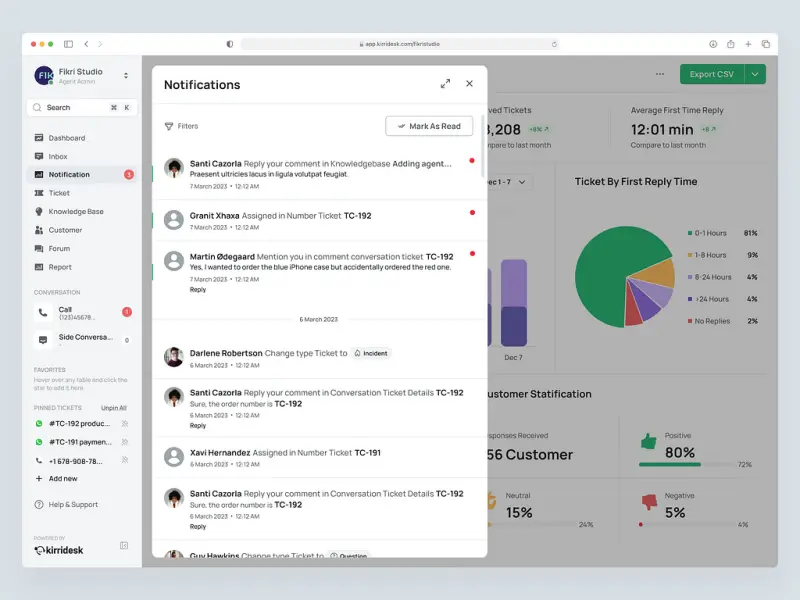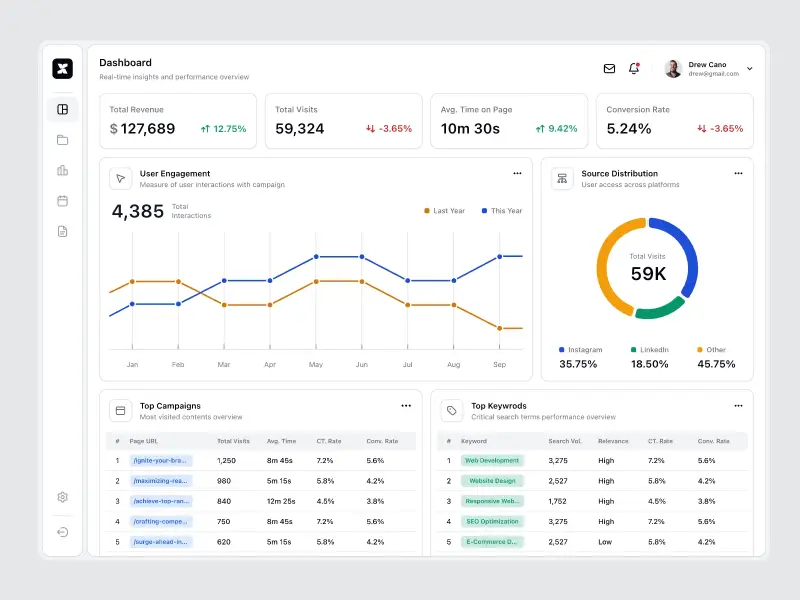Boost Efficiency with IT Support for Small Businesses
- TECHVIFY Team
- 0 Comments
Small businesses are the backbone of our economy, and having the right IT support for small businesses is essential for fostering innovation, creating jobs, and strengthening local communities. While medium and large enterprises may dominate in revenue and clientele, small businesses stand out for their personalized customer service and ability to build meaningful relationships with their customers. However, to keep pace with changing market demands and ensure long-term success, small businesses must embrace technological advancements and optimize their IT infrastructure.
Here are some eye-opening statistics that highlight the importance of having robust IT support:
- 46% of all cyber breaches affect businesses with fewer than 1,000 employees.
- 27% of small businesses lack any form of IT support.
- Small businesses are increasingly targeted by hackers.
- IT downtime costs small businesses an average of $427 per minute.
These figures make it clear: small businesses cannot afford to overlook IT support. In this guide, we’ll explore the key components of IT support and the various service models available to help small businesses thrive in today’s digital landscape.
I. The Value of Outsourcing IT Support for Small Businesses
Small businesses often face an uphill battle when it comes to managing resources and staying within tight budgets. Add the challenges of inflation and economic uncertainties, and it becomes clear why maintaining an in-house tech support team is increasingly impractical for many.
At the same time, customer expectations for prompt, efficient support remain high, regardless of a business’s size. This is where outsourcing tech support can be a game-changer. Partnering with a reliable remote support vendor allows small and medium businesses (SMBs) to meet these expectations while focusing on their core objectives, like driving growth and enhancing customer relationships.
IT support services for small business
By utilizing professional IT support for small businesses, SMBs can streamline operations, enhance customer satisfaction, and remain competitive in an ever-evolving landscape. Let’s explore six key reasons why outsourcing tech support is a smart move for small businesses:
-
Keeping Pace with Rapidly Evolving Technology
Technology evolves at lightning speed, and keeping up with the latest tools, software, and trends requires specialized knowledge. Outsourcing ensures your business has access to cutting-edge solutions and expertise to resolve technical issues efficiently. -
Strengthened Cybersecurity
As technology advances, so do cyber threats. Small businesses are often prime targets for cyberattacks due to outdated security measures or limited resources. A tech support vendor can proactively identify vulnerabilities and implement robust protections, safeguarding your business from current and future threats. -
Scalability and Agility
Outsourcing tech support provides flexibility that in-house teams often cannot match. Whether you need to scale support up during peak seasons or down during quieter periods, outsourcing allows you to adjust effortlessly to market demands without long-term commitments. -
Access to Specialized Expertise
Remote tech support partners offer a diverse talent pool with expertise across software, hardware, cloud services, and more. This ensures your business receives comprehensive support without the need to invest in costly hiring or training programs. -
Enhanced Customer Experience
Professional tech support providers are equipped to resolve issues quickly and effectively, boosting customer satisfaction. Delegating support tasks to experts allows you to maintain a high standard of service, even as customer demands grow. -
Cost-Efficiency
Outsourcing eliminates the need for hiring, training, and retaining an in-house IT team, providing cost-effective IT help for small businesses that allows them to focus on growth. Instead, you gain access to tailored, cost-effective solutions that align with your business needs—without unexpected expenses.
Learn More On:
II. IT Support Models for Small Businesses
Choosing the right IT support model depends on your business’s size, budget, technical requirements, and the level of support needed. Below are the most common service models available:
1. On-Demand Support
This model is ideal for businesses that only need IT support occasionally. On-demand support allows you to contact a provider whenever technical issues arise, without committing to long-term contracts. You’re billed based on the time spent or services rendered, making it a flexible and cost-effective option for businesses with minimal IT needs. However, it may not be ideal for companies requiring frequent or immediate assistance, as availability can vary depending on the provider.
2. Retainer-Based Support
With this model, businesses enter into a contractual agreement with an IT support provider. A fixed monthly or quarterly fee is paid in exchange for a predetermined scope of services, response times, and allocated resources. This approach offers predictable costs and ensures that support resources are readily available when needed. Retainer-based support is an excellent choice for businesses that value consistent service and want to avoid unexpected expenses.
3. Dedicated Support Team
For businesses with complex IT environments or specialized needs, a dedicated support team provides personalized attention. This model assigns an exclusive team of IT professionals to handle your business’s technology requirements. It’s a great solution for companies needing in-depth knowledge of their IT infrastructure, but it often comes with higher costs compared to other models.
4. Project-Based Support
If your business requires IT assistance for specific initiatives—such as migrating to the cloud, deploying new software, or upgrading hardware—project-based support is a practical option. The provider works with your team throughout the project’s duration, ensuring the successful completion of tasks within the agreed-upon scope. This model is temporary and focused solely on achieving the project’s objectives.
IT Support for Small Businesses
5. Managed Services
Managed services involve outsourcing the management and maintenance of your IT systems to a third-party provider. This model is comprehensive, covering everything from network monitoring and cybersecurity to backups and software updates. Managed service providers (MSPs) take a proactive approach, identifying and resolving issues before they escalate. For a fixed monthly fee, businesses gain access to ongoing support, ensuring their IT infrastructure remains secure, efficient, and up-to-date.
III. Common IT Problems for Small Businesses
Small businesses often face unique IT hurdles that can hamper growth and efficiency. Recognizing these challenges is the first step in overcoming them. Here’s a closer look at the most common issues and how IT support can help tackle them:
1. Tight Budgets
Small businesses often struggle with limited financial resources for IT infrastructure and support. This can lead to outdated systems, insufficient cybersecurity measures, and a lack of dedicated IT staff. A qualified IT provider can help small businesses make the most of their budgets by recommending cost-efficient tools and scalable solutions.
2. Challenges with Growth
Scaling IT infrastructure to match business growth can be difficult. Adding new users, upgrading software, and expanding networks can disrupt operations without proper planning. IT support providers can help small businesses implement scalable systems that grow alongside their needs, ensuring seamless transitions.
3. Risks of Data Loss
Data loss can severely impact small businesses, whether due to hardware failure, accidental deletion, or cyberattacks. Without a reliable backup and recovery system, businesses risk losing critical information. IT support can implement automated backups and recovery plans to safeguard your data and minimize downtime in case of a failure.
4. Exposure to Cybersecurity Threats
Small businesses are increasingly targeted by hackers, making IT support services for small businesses a necessity to protect operations and data. Threats like phishing, ransomware, and data breaches can cause financial and reputational harm. IT providers can strengthen your defenses through firewalls, antivirus software, employee training, and proactive monitoring to minimize risks.
By leveraging the right IT support services for small businesses, companies can address these challenges, creating a secure and efficient technology environment that drives growth and long-term success.
Looking for an Outsourced IT services partner?
TECHVIFY is the best option for you. Book a free consultation for an accurate time and cost estimation for your project.
IV. Tips to Choose the Right Service Model
Finding the perfect tech support model involves understanding your business’s unique needs and aligning them with the right solution. Here’s how to make the best choice:
-
Assess Your Support Requirements
Evaluate the volume and complexity of your support requests, desired response times, and level of customization needed. For example, if you need constant monitoring, managed services might be the best fit. -
Consider Your Budget
Determine how much you can allocate to tech support services and weigh each model’s cost against your business needs. On-demand support may be more economical for occasional needs, while retainer-based or managed services offer predictable expenses for ongoing requirements. -
Evaluate Response Times and Availability
If quick response times or 24/7 availability are critical, prioritize models that guarantee round-the-clock support or fast response times, such as a dedicated team or managed services. -
Assess Internal Resources
Consider your existing in-house IT capabilities. If your team lacks the expertise to handle complex issues, look for models that provide specialized skills or a dedicated IT team. -
Plan for Long-Term Growth
Think about your future needs. If you anticipate scaling operations or expanding services, opt for a model that accommodates growth, such as managed services or a dedicated support team. -
Research Vendors Thoroughly
Compare vendors by reviewing their track record, customer feedback, and service level agreements (SLAs). Ensure they meet your expectations for security, response times, and overall service quality.
V. How to Maximize the Benefits of IT Support
Be Specific When Communicating
Clear communication is essential for resolving IT issues effectively. When contacting your IT support provider, describe the problem thoroughly, including error messages, the steps taken before the issue occurred, and how it affects your business operations. Providing detailed information enables IT professionals to diagnose and fix the issue more quickly, reducing disruptions.
Maximize Benefits of IT Support for Small Businesses
Maintain Accurate IT Documentation
Having detailed records of your IT infrastructure—such as hardware, software, network configurations, and relevant credentials—can significantly speed up troubleshooting processes. This documentation provides IT support with valuable insights into your systems, making it easier to resolve problems efficiently and implement solutions tailored to your setup.
Train Employees on IT Basics
Educating your staff about basic IT practices can prevent unnecessary support requests and improve overall productivity. Teach employees how to identify phishing attempts, use secure passwords, and operate your business’s technology effectively. This proactive approach minimizes errors and ensures that your team is equipped to handle minor issues independently.
Stay Ahead with Regular Maintenance
Preventative maintenance is key to keeping your systems reliable and secure. Regularly updating software, applying security patches, and replacing outdated hardware can help avoid unexpected failures. This proactive strategy ensures smoother operations and protects your business from vulnerabilities that could lead to costly downtime.
Build a Strong Partnership with Your Support Provider
Developing a good working relationship with your IT support provider is essential. When they understand your business goals and systems, they can deliver more effective and personalized solutions. Regular communication fosters trust and ensures your provider can anticipate your needs rather than just reacting to problems.
Conclusion
Choosing the right IT support for small businesses is key to securing your business’s growth, efficiency, and resilience. By aligning your IT strategy with your needs, you can overcome challenges, protect your data, and scale with confidence.
At TECHVIFY, we provide tailored IT solutions to help small businesses thrive. Whether you need on-demand support, dedicated teams, or managed services, our experts are here to help.
Contact TECHVIFY today for a free consultation and discover how we can turn your IT challenges into opportunities. Let’s build smarter, scalable systems for your success.
TECHVIFY – Global AI & Software Solution Company
For MVPs and Market Leaders: TECHVIFY prioritizes results, not just deliverables. Reduce time to market & see ROI early with high-performing Teams & Software Solutions.
- Email: [email protected]
- Phone: (+84)24.77762.666








